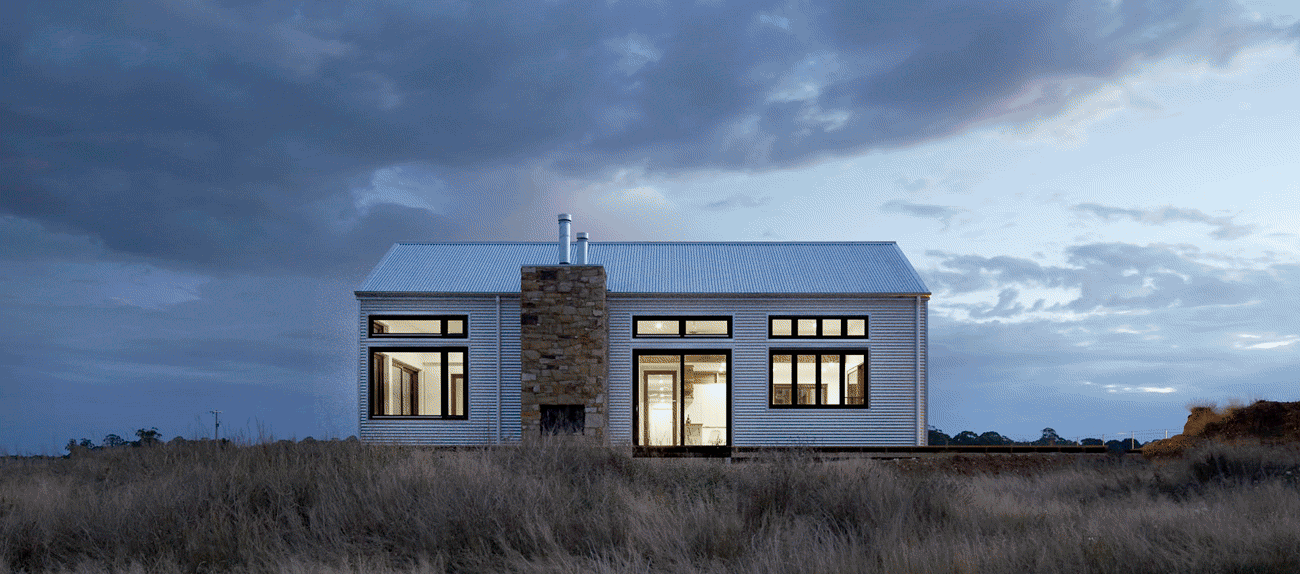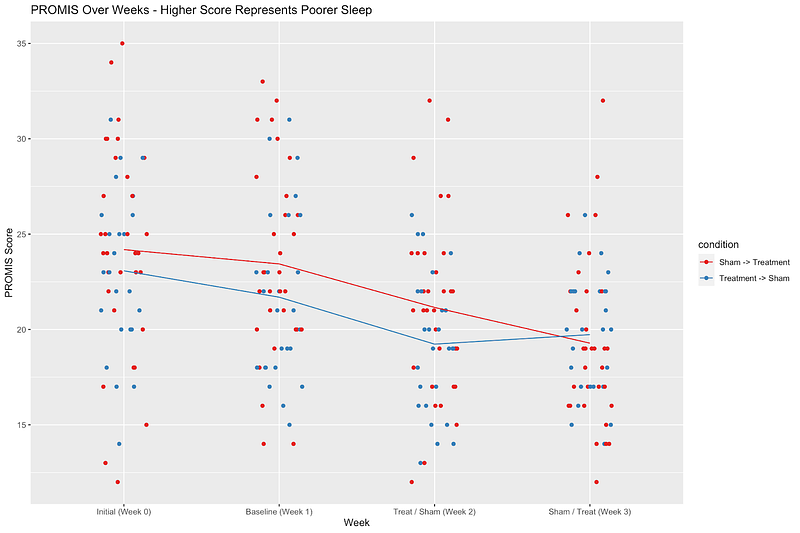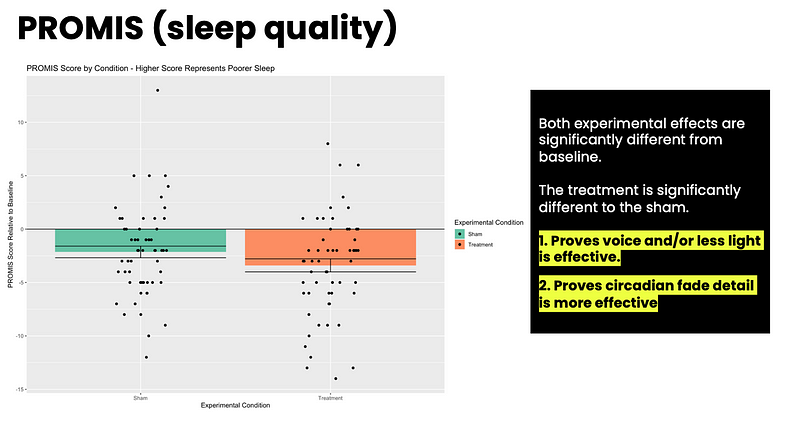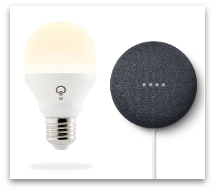Can Smart Lights Improve Your Sleep Quality?
A review of lights that turn red at wind down and brighten at wake up
By Dr. Dan Gartenberg
Last Updated: June 23, 2023
Smart Light Study Overview
When I think about sleep enhancement, I think about creating the perfect sound, light, and temperature environment. When these factors are combined together we can create the smart bedroom of the future and dramatically improve public health. Light is well established as a tool that impacts sleep, particularly regarding the finding that blue light at night keeps us awake. But light and sleep have an ancient and well studied relationship through the role that light plays in controlling the release of melatonin. After all, every single organism on the planet has some type of circadian rhythm that respond to light.
Recent developments in technology have made it easier for developers and mad scientists like me to answer questions like: can we change light via color, brightness, and hue at the right time to improve every human’s sleep? My collaborator Dr. Anne-Marie Chang did some of this foundational work around the impact that blue-light emitting technology has on circadian phase shift. She showed that lights can be harmful to sleep when exposed to blue light at night. But can they also be helpful?
To answer this question, my team at SleepSpace collaborated with my colleague Sam Moore, director at LIFX smart bulbs, and the Google Nest team, including one of their research scientists, Dr. Logan Schneider. We set out to discover whether lighting, when controlled by a smart assistant like Google Home, could help people with their sleep. We then integrated the LIFX technology within the SleepSpace app to create healthy wind down and wake up rituals. I made this video tutorial of how to connect LIFX to SleepSpace to simulate sunset and sunrise light experiences at the right time in your circadian rhythm.
There is always a tricky tension when it comes to technology and sleep because often times technology is the very cause of the problem. This is what Anne-Marie found. But perhaps with the right type of computer interaction, we can seamlessly control our lights to optimize our health, without the tech being a distraction or nuisance. Our hypothesis is that lights that gradually fade out when you should go to bed and brighten when you wake up to an alarm over a 30 minute period will help people have better perceived alertness.

The reason a gradual smart light regime might positively impact daytime alertness is that fading out light reduces light exposure during the night-time. Excessive light exposure, especially when lights are emitting blue frequencies, provides signals to photoreceptors in your eyes that you should be awake, when in reality you should be winding down for bed. Light that gradually brightens in the morning could also act on these receptors to make people more alert in the morning and throughout the day. Another factor that may be at play is related to stimulus control, or associating things in your bedroom with sleep. The ritual of interacting with lights during your wind down and wake up could help train you to go to bed at more consistent times, which could help with your perceived alertness.
Methodology
In order to be included in the study, participants could not be a shift worker and had to own a Google Nest and at least 2 LIFX smart bulbs. Here is what we did to test out the impact of smart lights on 66 sleepers aged 18–68.
Recruitment
We recruited participants by offering them free devices in exchange for their participation in a 3-week study. We asked participants to fill out a digital sleep diary on the SleepSpace platform every day. Additionally, participants completed weekly surveys that have been validated to measure sleep quality, such as the open source Patient-Reported Outcomes Measurement Information System (PROMIS) survey. Participants were also asked to track their sleep using the SleepSpace nearable sleep sensing technology called the SleepSpace Smart Bed, or with an Apple Watch when the participant chose to wear the watch during sleep.
Sham
The sham condition was designed for the lights to not impact sleep quality, but for the participants to believe that they lights were doing something to help with their sleep. Participants were instructed to interact with their Google Home Assistant 30 minutes before their bedtime and say: “Hey Google, set my all my lights to 50%.” This would turn their smart lights to 50%. Then when the participant indicated that they went to bed by pressing a button in SleepSpace, the lights turned off. In the morning, when the the participant indicated they woke up, we briefly popped the lights on at 1% brightness.
Treatment
Participants were similarly instructed to interact with their Google Assistant 30 minutes before their bedtime, but say, “Hey Google, sleep all my lights.” This would gradually dim all the lights in the participants home over a 30 minute period. Then they were instructed to say, “Hey Google, wake my bedroom light at XX:XX AM.” This would gradually ramp up the light in their bedroom over a 30 minute period at their decided wake up time.
By manipulating the lights in this way, we could see if gradually dimming and brighting the lights at the best time to go to bed and wake up can improve sleep compared to controlling smart lights in a way that should not have an impact on sleep (the sham condition). By giving participants commands in both conditions that control their lights, we are able to compare the impact of the ideal lighting environments while factoring out the impact of making commands to Google at designated times. When the sham week started for participants, they were still under the impression that they were changing lights to improve their sleep, which addresses possible placebo effects.
Results
We measured sleepiness using the PROMIS survey 4 times: onboarding, after baselines week, after sham/treatment week, and after the final sham/treatment week. I like to just plot everything first before we run statistics. In the below graph the dots represent every participant in the study and the lines represent the averages between conditions and over time.

When Dr. Dan Roberts, CSO of SleepSpace showed me this data, I was super excited! The PROMIS survey asks the participant about multiple aspect of the quality of their sleep, with lower scores indicating better perceived sleep quality. Some observations…
-
Participants in the sham first condition for some reason were randomly selected to have slightly worse perceived sleep quality.
-
There was a bit of a Hawthorne effect, from starting observation in the baseline week where there looks like a slight improvement even when no intervention was being undertaken.
-
It looks like we might have gotten the interaction we were looking for! Experimental psychologists (like me) love a good interaction and you can see it in the crossover on the graph over the week 2 and week 3 timepoints.
-
During the second week, both sham and treatment showed improvements. This makes sense because even in the sham condition we were instructing participants to change their lights during the right time based on their schedule. The AWESOME THING is that during the third week, for the sham condition participants perceived sleep quality looks like it gets worse, while for the treatment condition it continues to improve. This is exactly what we were hoping to find based on our hypothesis! But let’s dig a bit deeper and make sure that is a real effect we are seeing.
Statistics
We ran a 2X2 within groups ANOVA with week as one variable (week 2 vs week 3) and condition as the other variable (sham vs treatment). We found a significant interaction between week and condition where the treatment condition had better perceived sleep quality than the sham condition (p < 05), driven by improvements in the third week of the study. This provides strong evidence that fading the lights gradually at your designated bedtime and ramping them up gradually at your designated wake up time can improve how you feel about your sleep.

What’s more is that participants in all the conditions improved their perceived sleep quality over the 3-week study. This suggests that the simple act of setting an ideal bedtime and wake up time and being more aware of these times can help anyone improve their sleep quality in as little as 3 weeks.
Next Steps
We plan to extend this finding to a larger population of individuals who suffer from insomnia and determine if changing the hue of the lights can further improve on sleep quality. We are currently conducting this study in a randomized controlled trial funded by the National Institute of Aging. Based on a combination of your sleep goals and your natural rhythms, there is likely an ideal light environment that can help both healthy people and individuals who suffer from poor sleep. While technology often does more harm than good (i.e. the blue light emanating from your phone when you should be winding down for bed), at the end of the day, technology is just a tool. It can be used for good, and it can be used for evil. Maybe a smart home environment that takes the human into the center of the picture can finally create this reality where the tech does more good than harm.
What You Can Do
We often don’t think about our lighting much when it comes to our sleep. Some quick hacks that I’ve personally found helpful around light exposure include:
-
Get 30 minutes of sunlight a day and if not sun try a 10000 lux happy lamp.
-
Try to get dim lighting after the sunsets, preferably with a red hue that can be programed by LIFX bulbs.
-
Integrate your LIFX bulbs with SleepSpace and automatically change all your lights red at your wind down and brighten them at wake up.
Wake up with a simulated sunset. -
Have a consistent ritual around the same time every day to entrench your circadian rhythm.
-
Try controlling a smart bulb like LIFX with an assistant like Google’s. It takes a little while to get used to the commands, but its worth it!
Please drop me a note if you have any questions or have any interest in participating in one of our future studies. SleepSpace can help companies and individuals evaluate what works and what does not work when it comes to our sleep health. In todays age, it is often up to each individual to find the sleep environment that works best for them in order to improve their alertness, productivity, and well-being.

